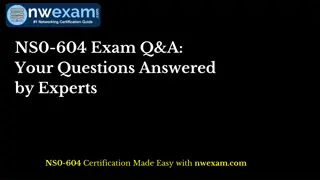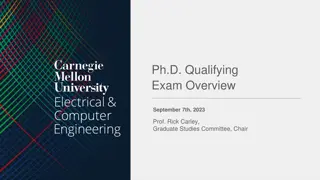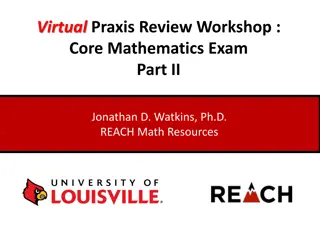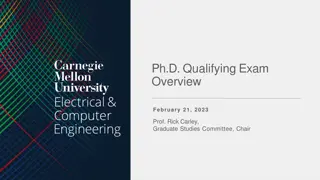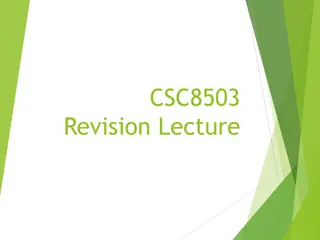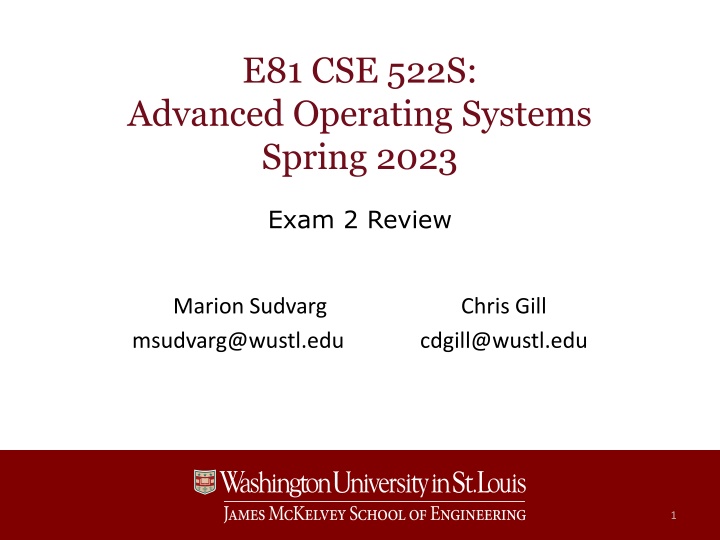
Operating Systems Exam Review and Docker Overview
Prepare for the Advanced Operating Systems exam with key information on exam format, materials allowed, Docker automation, and building Docker images. Be ready for the test and enhance your understanding of containerization concepts.
Download Presentation

Please find below an Image/Link to download the presentation.
The content on the website is provided AS IS for your information and personal use only. It may not be sold, licensed, or shared on other websites without obtaining consent from the author. If you encounter any issues during the download, it is possible that the publisher has removed the file from their server.
You are allowed to download the files provided on this website for personal or commercial use, subject to the condition that they are used lawfully. All files are the property of their respective owners.
The content on the website is provided AS IS for your information and personal use only. It may not be sold, licensed, or shared on other websites without obtaining consent from the author.
E N D
Presentation Transcript
E81 CSE 522S: Advanced Operating Systems Spring 2023 Exam 2 Review Marion Sudvarg msudvarg@wustl.edu Chris Gill cdgill@wustl.edu 1
Exam Time and Location Tuesday, April 18 10-11:20AM Urbauer 216 (normal class time and place) CSE 522S Advanced Operating Systems 2
Studios Reminder: Studios 11-15 are due by Monday, April 17, at 11:59PM One submission per team in Canvas, please If you have a studio marked Incomplete please address the comment! Let us know by email ASAP if you need an extension, and the reason for that request CSE 522S Advanced Operating Systems 3
Exam Format Mostly short answer Explain why the following is false Some matching of terms Largely intended to test your understanding of concepts What does this do? When would you use this? Where is this implemented? Why was this important? CSE 522S Advanced Operating Systems 4
Materials Allowed Open book, open notes What is allowed: Any handwritten or printed notes Any textbooks An electronic notebook without internet capabilities, if approved by instructor(s) in advance - please ask us What is not allowed: Internet-capable laptops, tablets, phones, etc. We will have two extra copies of all textbooks Recommendation: write a 1-2 sided notes page! Writing it will help you study Easier to access during exam than printing all notes! CSE 522S Advanced Operating Systems 5
Docker Automates container creation Provides container monitoring and management Leverages namespacesand cgroups Modular software architecture: Client/Server Docker Daemon provides API to clients containerd supervises and controls state of running containers runc launches a container shim process retains minimal environment for each container to communicate with containerd after runc exits CSE 522S Advanced Operating Systems 6
Building Docker Images Dockerfile Image Container Docker images are layered Layers are additive A Dockerfile can inherit from a base image Use multistage builds to improve efficiency (build time and image size) CSE 522S Advanced Operating Systems 7
Working with Docker Containers Understand the following ideas: Containers can run in the background Entering, viewing, stopping containers Container resource persistence and cleanup Bind-mounting a host directory into a container Using Docker named volumes How Docker resource constraints correspond to cgroups CSE 522S Advanced Operating Systems 8
Network Namespaces Network namespaces enable isolation of network resources Isolate processes from the network Create secure network applications Create virtual network devices veth: a virtual ethernet interface bridge: a virtual switch Connect isolated container networks with bridges, route and iptables rules Use NAT or a bridge gateway to allow containers to reach outside networks Use port forwarding with iptables to allow outside traffic to reach a container hosting a service CSE 522S Advanced Operating Systems 9
Docker Networking Docker Network Drivers: none: The container has no networking capabilities host: The container is not placed in a new network namespace bridge: The default network driver; the container is attached to a bridge Port Forwarding: Allows external traffic to access services provided by Docker containers Traffic is forwarded by a docker-proxy process Docker Compose automates the creation of applications with multiple networked containers CSE 522S Advanced Operating Systems 10
CPU Virtualization Virtual machines provide strong isolation Each VM hosts its own operating system kernel Hypervisor Types Type 1: hypervisor runs directly on hardware (no host operating system) Type 2: hypervisor runs within host operating system Instruction emulation Guest OS runs as a user-mode process All instructions are checked (and translated, if necessary) Hardware virtualization Typically more efficient than emulation Introduces guest/supervisor mode, orthogonal to user/kernel mode Allows instructions to run directly on hardware Hypervisor can trap (intercept) certain privileged instructions CSE 522S Advanced Operating Systems 11
Memory Virtualization We cannot allow guest kernels direct access to physical memory and page tables Introduce an extra level of indirection: Guest Virtual -> Guest Physical -> Host Physical Shadow Page Tables: Hypervisor maintains a shadow copy of guest page tables Instructions to set CR3 or map a new page are trapped by hypervisor High VM-exit overhead for guests that frequently context-switch or map memory Nested/Extended Page Tables Guest-physical addresses are themselves translated in hardware A 4-level page table requires 24 nested lookups on TLB miss Does not require VM-exit; page tables set up by hypervisor as guest boots CSE 522S Advanced Operating Systems 12
Device I/O Device I/O ports, registers, and memory are addressed similarly to main memory Some architectures (e.g., x86) use a different instruction to address I/O ports (still conceptually similar) Architecture-specific kernel macros provide a wrapper fa ade Map I/O memory (modify page tables) with ioremap Use ioread/iowrite wrapper functions for access Be mindful of compiler optimizations, instruction reordering, memory barriers, and caching! CSE 522S Advanced Operating Systems 13
Direct Memory Access (DMA) Virtual Memory Areas are object-oriented (similar to VFS), allow drivers to define open and close functions Peripheral devices can be given direct access to main memory, bypassing the CPU Synchronous DMA Driver s read function allocates a DMA buffer, maps into process Driver provides hardware with buffer address Hardware writes data to buffer, raises interrupt Interrupt handler in driver awakens process Asynchronous DMA Device writes data to buffer directly, even when no process is waiting Commonly used in network cards Bus Addresses Devices address main memory using bus addresses! Kernel provides platform-specific wrapper functions to portably convert physical/logical addresses to bus addresses CSE 522S Advanced Operating Systems 14
I/O Virtualization 3 Primary Approaches Device emulation Hypervisor emulates a device Typically slowest approach Optimizations may provide better performance in certain scenarios I/O paravirtualization Hypervisor provides an explicit interface to underlying hardware Modified guest kernel uses special drivers that make hypercalls Simplifies instructions that guest kernel must make Direct device assignment Assign a hardware device directly to a VM Device memory regions are mapped directly into the guest (via IOMMU) CSE 522S Advanced Operating Systems 15
Good Luck! That said, please also remember that Fortune favors the prepared mind. Louis Pasteur Any questions? CSE 522S Advanced Operating Systems 16









